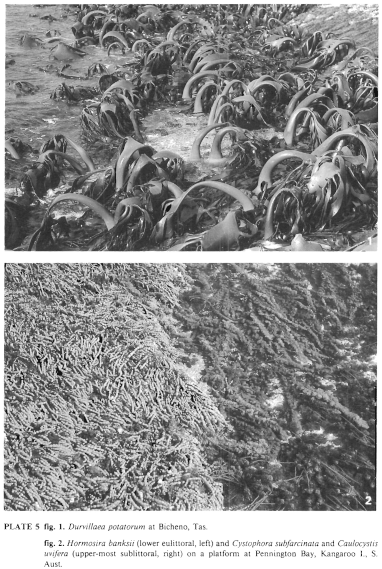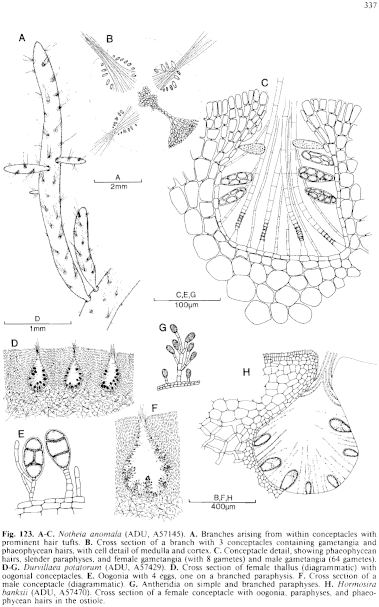|
|
|
|
|
|||||||||||
|
Electronic Flora of South Australia Species Fact Sheet
Phylum Phaeophyta – Order Durvillaeales – Family Durvillaeaceae
Selected citations: Clayton et al. 1987: 35, figs 1–32. Harvey 1863: pl. 300. Hay 1979b: 195, fig. II. Womersley 1967: 249.
Synonym
Focus potatorum Labillardière 1806–7: 112, pl. 257. Turner 1819: 106, pl. 242.
Thallus (Plate 5 fig. 1) dark brown, younger parts medium brown, usually 2–8 m long, with a massive discoid to broadly conical holdfast 5–25 cm across and 0.5–4 cm thick in mature plants, with a single (rarely 2–3 by fusion of holdfasts) stout, terete stipe (5–) 10–50 cm long and 2–8 (–12) cm in diameter, usually without but occasionally with 1–2 proliferous laterals, bearing a divided, complanate, leathery frond with long segments, divided to near the base or to any position, usually (5–) 10–40 cm broad and 0.5–2 cm thick near the base, slenderer above with ultimate segments linear to gently tapering, usually 2–20 mm broad and 2–5 mm thick; blades often proliferous from the margins above the stipe, probably partly following damage. Growth diffuse, probably mainly in upper parts and the meristoderm. Structure apparently haplostichous from an early stage, with a broad filamentous medulla, largely of hyphae, and a cortex of radial, branched, filaments of cells, with an outer meristoderm; outer cells with numerous discoid phaeoplasts, without pyrenoids. Phaeophycean hairs absent, except within ostioles of conceptacles.
Reproduction: Plants dioecious. Conceptacles densely scattered over the thallus, present in winter. Female conceptacles (Fig. 123D) with oogonia on the wall and on branched paraphyses. oogonia (Fig. 123E) ovoid, 50–75 µm long and 30–35 pm in diameter, producing four eggs. Male conceptacles (Fig. I23F) with antheridia on branched, tufted, paraphyses (Fig. 123G), elongate-ovoid, 16–24 µm long and 7–12 µm in diameter.
Type from "Cape van Diemen" (S.E. Tasmania); in Fl.
Selected specimens: Robe, S. Aust., sublittoral fringe ( Womersley, 29.viii.1949; ADU, A10886). Flat Rock, Bridgewater Bay, Vic., upper sublittoral (14 Womersley, 21.iii.1953; ADU, A18959). Point Lonsdale, Vic., 4–5 m deep (Leming, 20.i.1948; ADU, A56115). Queenscliff, Vic., drift ( Womersley, 28.ix.1986; ADU, A57429). Three Hummocks I.. N.W. Tas., very low eulittoral (Bennett, 17.i.1954; ADU, A19693). Eaglehawk Neck, Tas., low eulittoral (Levring, 29.i.1948; ADU, A56114). Bermagui, N.S.W., on far out rocks (May 2032, 26.i.1946; NSW).
Distribution: From Margaret Brock Reef, off Cape Jaffa, S. Aust. to Bermagui, N.S.W. and the west, south and eastern coasts of Tasmania where wave action is considerable.
Taxonomic notes: D. potatorum occurs on rough-water coasts as a fringe zone to the sublittoral, but at Eddystone Rock, S.E. of Tasmania, the Durvillaea zone extends to 18 m deep, with some plants to 30 m (Edgar 1984, p. 176). It is fertile in winter and conceptacles are not apparent in summer, apparently being obliterated by hyphal tissue.
References:
ARESCHOUG, J.E. (1854). Phyceae novae et minus cognitae in maribus extraeuropaeis collectae. Ada Reg. Soc. Sci. Upsala, Ser. III, 1, 329–372.
CLAYTON, M.N., HALLAM, N.D. & SHANKLY, C.M. (1987). The seasonal pattern of conceptacle development and gamete maturation in Durvillaea potatorutn (Durvillaeales, Phaeophyta). Phycologia 26, 35–45.
EDGAR, G.J. (1984). General features of the ecology and biogeography of Tasmanian subtidal rocky shore communities. Pap. Proc. R. Soc. Tas. 118, 173–186.
HARVEY, W.H. (1863). Phycologia Australica. Vol. 5, Plates 241–300, synop., pp. 1–73. (Reeve: London.)
HAY, C. (1979b). Nomenclature and taxonomy within the genus Durvillaea Bory (Phaeophyceae: Durvilleales Petrov). Phycologia 18, 191–202.
LABILLARDIÈRE, J.J. (1806–1807). Novae Hollandiae Plantarum Specimen. Vol. 2. (Plates 231–265 in 1807). (Huzard: Paris.)
TURNER, D. (1819). Fuci sive Plantarum Fucorum Generi a Botanicis Ascriptarum Icones Descriptiones et Historia. Vol. 4, pp. 1–153, Plates 197–258. (London.)
WOMERSLEY, H.B.S. (1967). A critical survey of the marine algae of southern Australia. II. Phaeophyta. Aust. J. Bot. 15, 189–270.
The Marine Benthic Flora of Southern Australia Part II complete list of references.
Publication:
Womersley, H.B.S. (14 December, 1987)
The Marine Benthic Flora of Southern Australia
Part II
©Board of the Botanic Gardens and State Herbarium, Government of South Australia
Illustrations in Womersley Part II, 1997: PLATE 5 fig. 1; FIG. 123 D–F.

Plate 5 enlarge
PLATE 5 fig. 1. Durvillaea potatorum at Bicheno, Tas.
fig. 2. Hormosira banksii (lower eulittoral, left) and Cystophora subfarcinata and Caulocystis uvifera (upper-most sublittoral, right) on a platform at Pennington Bay, Kangaroo I., S. Aust.

Figure 123 enlarge
Fig. 123. A–C. Notheia anomala (ADU, A57145). A. Branches arising from within conceptacles with prominent hair tufts. B. Cross section of a branch with 3 conceptacles containing gametangia and phaeophycean hairs, with cell detail of medulla and cortex. C. Conceptacle detail, showing phaeophycean hairs, slender paraphyses, and female gametangia (with 8 gametes) and male gametangia (64 gametes). D–G. Durvillaea polatorum (ADU, A57429). D. Cross section of female thallus (diagrammatic) with oogonial conceptacles. E. Oogonia with 4 eggs, one on a branched paraphysis. F. Cross section of a male conceptacle (diagrammatic). G. Antheridia on simple and branched paraphyses. H. Hormosira banksii (ADU, A57470). Cross section of a female conceptacle with oogonia, paraphyses, and phaeophycean hairs in the ostiole.

|
Email Contact: State Herbarium of South Australia |

|